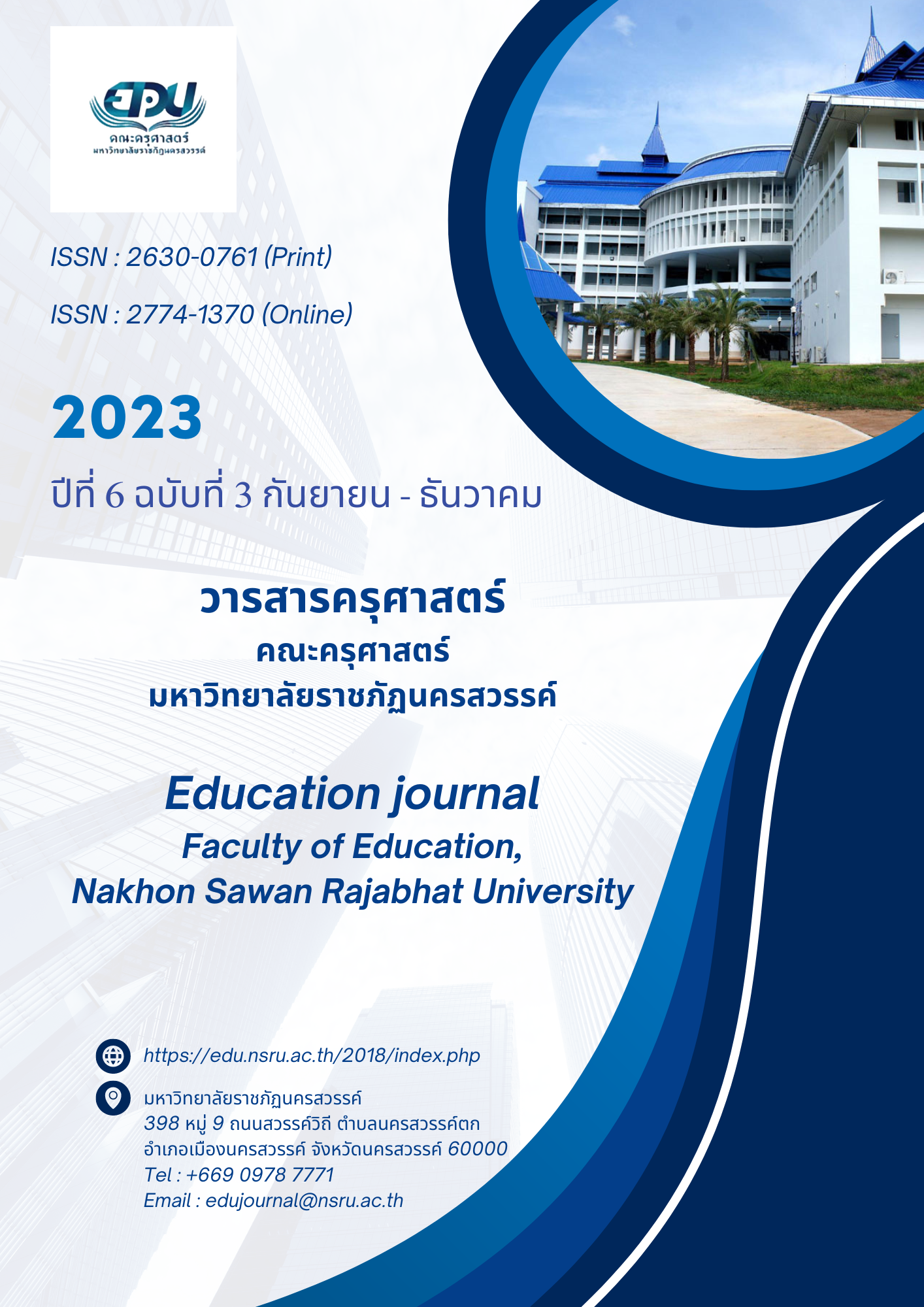Development of an Environment Learning Activities Package for Analytical Thinking Development of undergraduate students: a Case Study of Tha Kham Natural Island Mangrove Forest
Main Article Content
Abstract
The objectives of research were to 1) develop and evaluate the effectiveness of an environmental and 2) develop analytical thinking among second-year students in the Department of Environmental Science, using the environmental learning activities package. The sample consisted of 11 students from the Environmental Science Program, Year 2, Semester 1, Academic Year 2021, who were chosen by purposive sampling method. The research tools consisted of an expert assessment form for developing a package of learning activities, four sets of environmental learning activities, the achievement test, and an assessment form for analytical thinking. For data collecting, students were asked to take a test before participating in the learning activities. During the event, worksheet and analytical thinking scores were collected, and students were asked to take a test after participating in the learning activities.
The results showed that environmental learning activities package had been considered and evaluated by experts, with four sets of high-level assessment results. The environmental learning activities package was effective on criteria E1/E2=83.63/81.13. The results of analytical thinking development of Year 2 environmental science students from using of environmental learning activities package in real-world conditions showed that most of the students had good analytical scores, and analytical thinking was improved. The students’ achievement before and after using the environmental learning activities package was different, with a statistical significance of .05.
Downloads
Article Details

This work is licensed under a Creative Commons Attribution-NonCommercial-NoDerivatives 4.0 International License.
References
ชัยยงค์ พรหมวงศ์. (2545). เอกสารประกอบการสอนชุดวิชาเทคโนโลยีการศึกษา หน่วยที่ 1-5. กรุงเทพฯ: มหาวิทยาลัยสุโขทัยธรรมาธิราช.
ทิศนา แขมมณี, และคณะ. (2543). การคิดและการสอนคิด. ประมวลบทความนวัตกรรมเพื่อการเรียนรูสำหรับครูยุคปฏิรูปการศึกษา. กรุงเทพฯ: คณะครุศาสตร จุฬาลงกรณมหาวิทยาลัย.
เทศบาลตำบลท่าข้าม. (2564). สภาพพื้นที่โดยทั่วไปของเกาะธรรมชาติท่าข้าม. สืบค้นเมื่อวันที่ 29 กันยายน 2564, จาก http://www.thakam.go.th/_files/data/2017_01_24_024539_jzfz4h2s.pdf.
ธงชัย ต้นทัพไทย. (2548). การศึกษาผลสัมฤทธิ์ทางการเรียนรู้วิทยาศาสตร์และค่านิยมในการบริโภคอาหารของนักเรียนชั้นมัธยมศึกษาปีที่ 2 ที่สอนโดยใช้ชุดกิจกรรมพัฒนาศักยภาพการเรียนรู้ทางวิทยาศาสตร์. วิทยานิพนธ์ปริญญาการศึกษามหาบัณฑิต (หลักสูตรและการสอน). มหาวิทยาลัยศรีนครินทรวิโรฒ ประสานมิตร.
บุญชม ศรีสะอาด. (2545). การวิจัยเบื้องต้น. (พิมพ์ครั้งที่ 7). กรุงเทพฯ: สุวีริยาสาส์น.
ประพันธศิริ สุเสารัจ. (2556). การพัฒนาการคิด. (พิมพ์ครั้งที่ 5). กรุงเทพฯ: โรงพิมพ์ 9119 เทคนิคพริ้นติ้ง.
ประภาพรรณ เส็งวงศ์. (2551). การพัฒนานวัตกรรมการเรียนรู้ด้วยวิธีการวิจัยในชั้นเรียน. (พิมพ์ครั้งที่ 2). กรุงเทพฯ: อี. เค. บุ๊คส์.
นลินี อินดีคำ. (2551). ชุดกิจกรรมพัฒนาทักษะกระบวนการทางวิทยาศาสตร์ เรื่องสารรอบตัวสำหรับนักเรียนชั้นมัธยมศึกษาปีที่ 1. ปริญญาครุศาสตรมหาบัณฑิต (หลักสูตรและการสอน). มหาวิทยาลัยราชภัฏอุตรดิตถ์.
พวงรัตน์ ทวีรัตน์. (2540). วิธีการวิจัยทางพฤติกรรมศาสตร์และสังคมศาสตร์. (พิมพ์ครั้งที่ 7). กรุงเทพฯ: สำนักทดสอบการศึกษาและจิตวิทยา มหาวิทยาลัยศรีนครินทรวิโรฒ.
ไพฑูรย์ สินลารัตน์, และคณะ. (2557). คิดวิเคราะห์: สอนและสร้างได้อย่างไร. กรุงเทพฯ: โรงพิมพ์แห่งจุฬาลงกรณ์มหาวิทยาลัย.
วิชัย วงษ์ใหญ่. (2543). การพัฒนาหลักสูตร. กรุงเทพฯ: สํานักพิมพ์มาตรฐานการอุดมศึกษา.
ลักขณา สิริวัฒน์. (2549). การคิด. กรุงเทพฯ: โอเดียนสโตร์.
สาวิตรี พิพิธกุล. (2560). การพัฒนาโปรแกรมเว็บไซต์ระบบศูนย์ข้อมูลงานวิจัย มหาวิทยาลัยราชภัฏชัยภูมิ. วารสารชุมชนวิจัย. 11(1): 18-28.
สำนักงานเลขาธิการสภาการศึกษา. (2562). กรอบสมรรถนะหลักผู้เรียนระดับการศึกษาขั้นพื้นฐานและระดับประถมศึกษาตอนต้น (ป.1-3). กรุงเทพฯ: สกศ.
สำนักวิชาการและมาตรฐานการศึกษา. (2551). ชุดฝึกอบรมวิทยากรหลักสูตรแกนกลางการศึกษาขั้นพื้นฐานพุทธศักราช 2551 ชุดที่ 3 เรื่อง การจัดทำหน่วยการเรียนรู้อิงมาตรฐาน. กลุ่มพัฒนากระบวนการเรียนรู้ สำนักงานคณะกรรมการการศึกษาขั้นพื้นฐานกระทรวงศึกษาธิการ.
สุวิทย์ มูลคำ, และอรทัย มูลคำ. (2551). ครบเครื่องเรื่องการคิด. (พิมพ์ครั้งที่ 9). กรุงเทพฯ: ภาพพิมพ์.
Anderson, L. W., & Krathwohl, D. R. (2001). A Taxonomy for Learning, Teaching, and Assessing: A Revision of Bloom's Taxonomy of Educational Objectives. New York: Longman.
Bloom, B., et al. (1956). Taxonomy of educational objectives: Handbook I, The cognitive domain [Taxonomía de los objetivos educativos: Tomo I, El dominio cognitivo]. Nueva York, David McKay & Co.
Leary, M. R. (1996). Self-Presentation: Impression Management and Interpersonal Behavior. Westview Press, Boulder.
Marzano, Robert J. (2001). Desinging A New Taxonomy of Educational Objectives. California: Corwin Press, Inc.
Zeichner, Kenneth M., & Liston, Daniel P. (1987). Teaching Student Teachers to Reflect. Harvard Educational Review. 57(1): 23-48.


